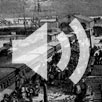Views
Views are short interpretive historical presentations from materials in the Railroads collection. Each View is aimed a research question or problem and assembles information from multiple sources: documents, lists, records, orginal maps, and other historical sources. Rather than using traditional footnotes or citations, these Views contain direct links and references to relevant sources used in their assembly. Views are "assemblages" of data and interpretation and should be considered multimedia experiments in the presentation of digital history.

Passenger Mobility in the 1850s
The first experience of the railroad for many Americans was a revelation. Passenger traffic developed quickly as the railroads extended their lines from city to city. Small towns became linked with the larger urban centers and Americans' increased mobility changed conceptions of time, space, distance, and identity.

Women’s Experience on the Great Plains in the 1850s
Sarah Sim and her husband Francis Sim migrated to Otoe County, Nebraska Territory, in 1856 to start a farm. Their trials and travails included the death of three of their children, the near suicide of Sarah, and the difficulties of moving to and farming in the Great Plains in the 1850s. This podcast with Leslie Working and William G. Thomas explores the significance of these letters and of the Sims’ experience in the years before the Civil War.

Death and Dying in 19th Century America
This podcast with William G. Thomas and Leslie Working considers the experience of death and dying for 19th century Americans and the significance of changing ideas about death in American society. Sarah Sim and her husband Francis Sim migrated to Otoe County, Nebraska Territory, in 1856 to start a farm. Their trials included the death of three of their children, the near suicide of Sarah, the difficulties of moving to and farming in the Great Plains in the 1850s, and the death of Sarah from breast cancer in 1880.

Railroads and Women's History on the Great Plains
NET Radio Interview with William G. Thomas and Leslie Working explores the project goals and the ways railroads have been presented in history.